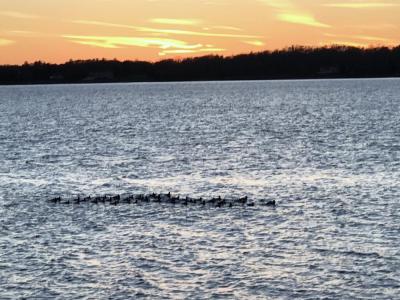Moon Tide Floods Estuaries for December 2021 Waterfowl Survey
On Sunday, December 5, the Lloyd Center for the Environment began its 35th Annual Winter Waterfowl survey under seasonably cool temperatures and minimal breeze - stellar counting conditions on the estuaries and coastal ponds from Sakonnet Point in Rhode Island to Padanaram Harbor in Dartmouth. Last year’s weather was balmy and the count was postponed a week due to weather, but again no ice existed and tides were extreme, making for a good comparison between the surveys. The tidal factor again made timing of surveys important at sites most affected by water level fluctuation, with Dartmouth estuaries a prime example of this effect on waterfowl distribution.
At Apponagansett Bay estuary below the bridge, the salt marsh creeks were flooded, so dabblers were virtually absent and only small numbers of open bay divers were seen, including a few Long-tailed Ducks and Common Loons. The common Bufflehead, adaptable to deep but preferring shallower waters, were fairly prevalent, but seen flying north of the bridge to evade the still incoming tide, and where both Red-breasted and Hooded Mergansers were active. Any dabbler and goose activity was focused at the north reaches, where numerous Gadwall were at rest along the drenched salt marsh through which Canada Geese were swimming and feeding.
A flock of about 50 Mallards were found hiding in a small tributary connected to the estuary, which provided good feeding and refuge while the tides were so high. The Hooded Mergansers, more secretive than their Red-breasted relative, were also seen at this shallow, secluded north tip.
At the Slocum and Little Rivers, the impact of tides on the dabblers was observed for American Black Ducks, which rely heavily upon these flowing estuaries. The birds packed in tightly in the shallows of the mouth of the Slocum, including Giles Creek tributary which is visible through our observatory scope, and in the corner of the vast expanse of Little River along Little River Road. Between the two sites, there were over 300 individuals, with the highest totals observed at Little River (184) and the Slocum River (128), respectively. The Little River section in particular attracts the Black Ducks at lower tides when the birds dabble in the shallows for invertebrates.
For two surveys conducted under highly similar conditions, The 4,587 total waterfowl counted this year was only 157 higher than the December 2020 survey. Declines occurred for some divers found including Scaup, Common Eider, and both Red-breasted and Hooded Merganser, all of which were likely deterred by the high tide. Canada Geese declined further by 242 birds to 837 total, the lowest December count since December 2014, with many geese feeding in upland buffer areas or occupying ponds with less dramatic tidal influences. Canada Geese were almost exclusive to the coastal ponds with peak abundance seen at Nonquitt (301), Salters (165), and Nannaquaket (112).
Subtle increases occurred for a number of species including Mute Swan, many dabblers (American Black Ducks, Mallard, Pintail, American Wigeon, and Gadwall) and Bufflehead. Common Goldeneye, more abundant in winter when freshwater freezes, increased slightly and were scattered about the estuaries in small numbers, including an identical number (14) again seen at the mouth of Little River where females often gather. The two ponds with the highest abundance of Scaup, Round (117), and Richmond (77), also showed increases of two more secretive diving duck species that have an affinity for ponds. A sizeable flock of Ring-necked Ducks (82), showed up at Round Pond, while a huge flock of Ruddy Ducks (237) was seen at Richmond Pond. Next to Canada Geese (301 Nonquitt Pond), this was the largest concentration of a species seen for this survey and the main contributor to the slight increase in overall waterfowl from last year’s count.
Of special note, the first ever “Tufted Duck”, an Aythya species most closely related to the Ring-necked Duck, but an accidental in the northeast only seen occasionally during migration, appeared on the Lloyd Center waterfowl survey for the first time on record. An immature bird confirmed at Richmond Pond, this and a few other sightings of the species made the Ebird “rare bird alert” as well as American Birding Association rarities list, which indicates only a handful of Tufted Ducks in the entire northeast this season.
It’s widely known that climate change is an ongoing and increasing concern in our environment, with trends for a waterfowl survey offering clues as to what’s happening. Will frigid temperatures and extensive ice return in late January as occurred a year ago, or will it be one of those unseasonably warm counts with no ice or snow to be found? Stay tuned for the outcome, and synopsis of the 35th Annual Winter Waterfowl Survey.
by Lloyd Center Research Associate, Jamie Bogart














